Abstract
Mice challenged intravenously with 10(6) viable Candida albicans died between 1 and 16 days after infection. Near the time of death, over 98% of the recoverable fungi came from the kidneys. Physiologically, animals were in renal failure near the time of death as evidenced by elevated blood urea nitrogen (BUN) and blood creatinine levels and a creatinine clearance rate which was about one-half normal. No abnormalities in liver glucogen and blood glucose levels were detectable. When mice were challenged with 4.5 X 10(6) viable C. albicans, they all died within 12 h. Near the time of death they had normal BUN values and were hyperglycemic. In mice receiving 4.5 X 10(6) heat-killed C. albicans, no deaths occurred and liver glycogen, blood glucose, and BUN levels all remained within a normal range and were different from responses to bacterial endotoxin. Cumulatively, the results demonstrate two distinct syndromes for the pathogenesis of experimental C. albicans infections. At the lower dose, mice were in renal failure associated with progressive renal infection. At the higher dose, renal failure was not observed. If a toxin was associated with death from the latter dose, it was not similar to bacterial endotoxin.
Full text
PDF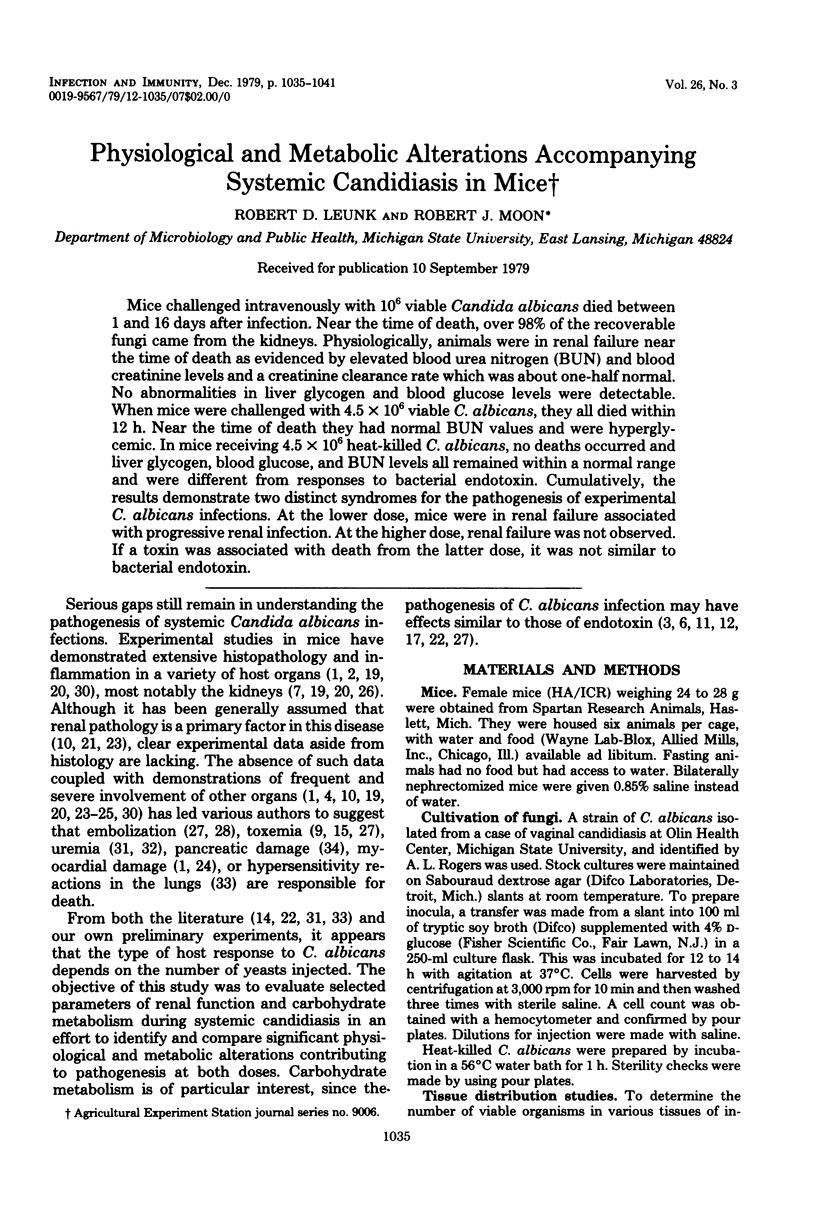
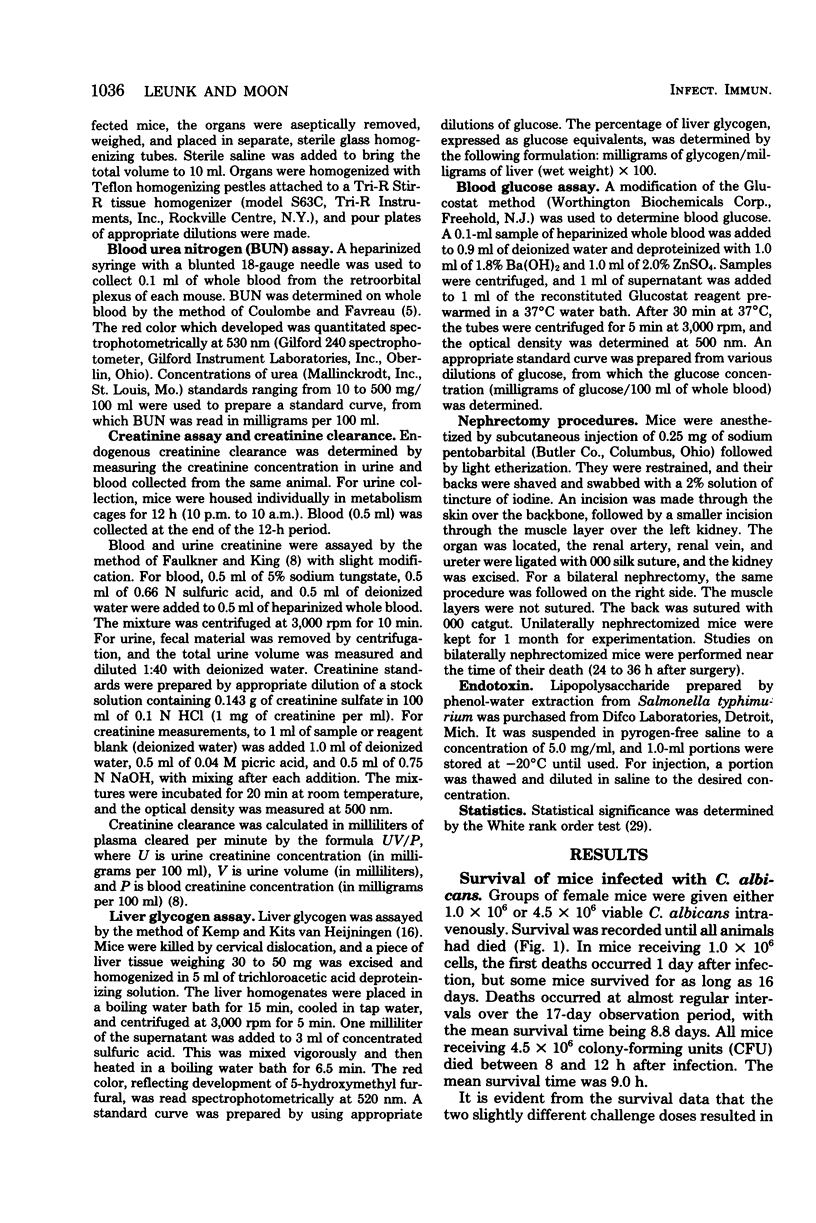
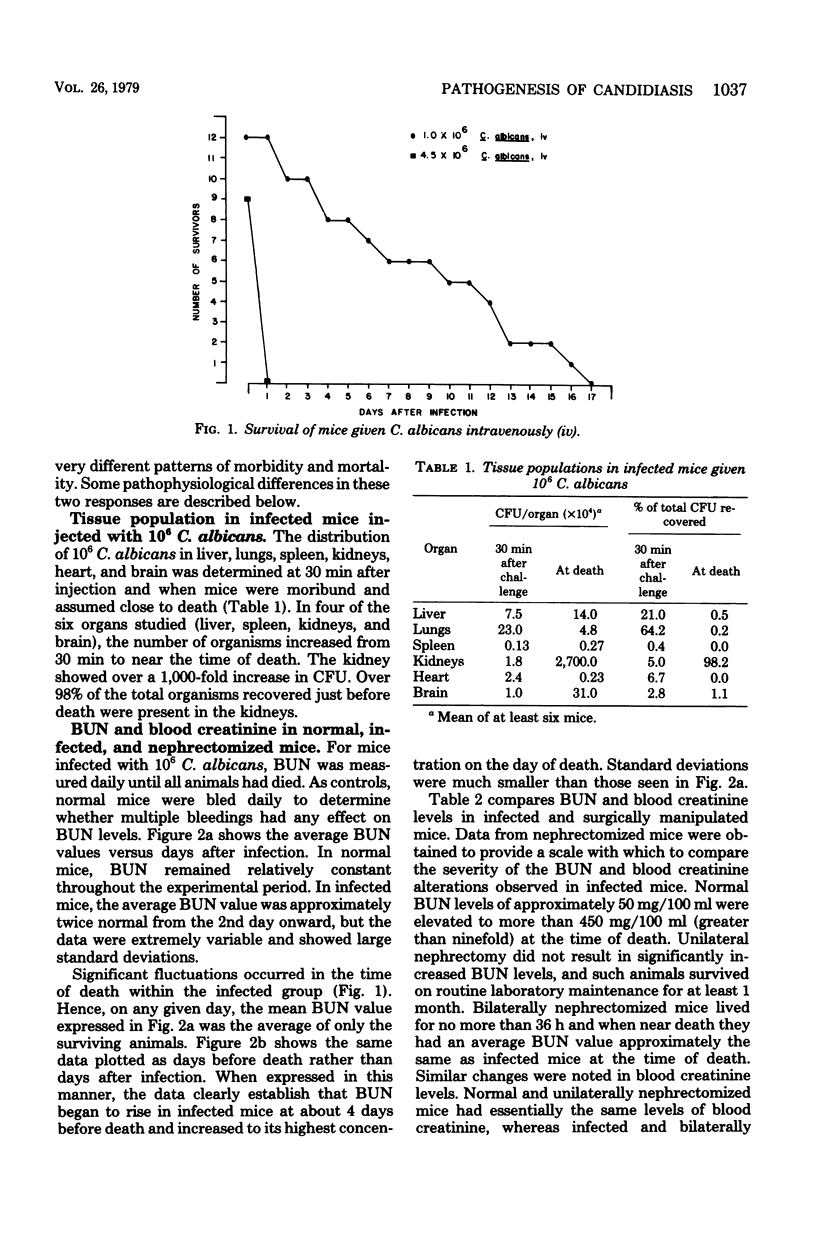
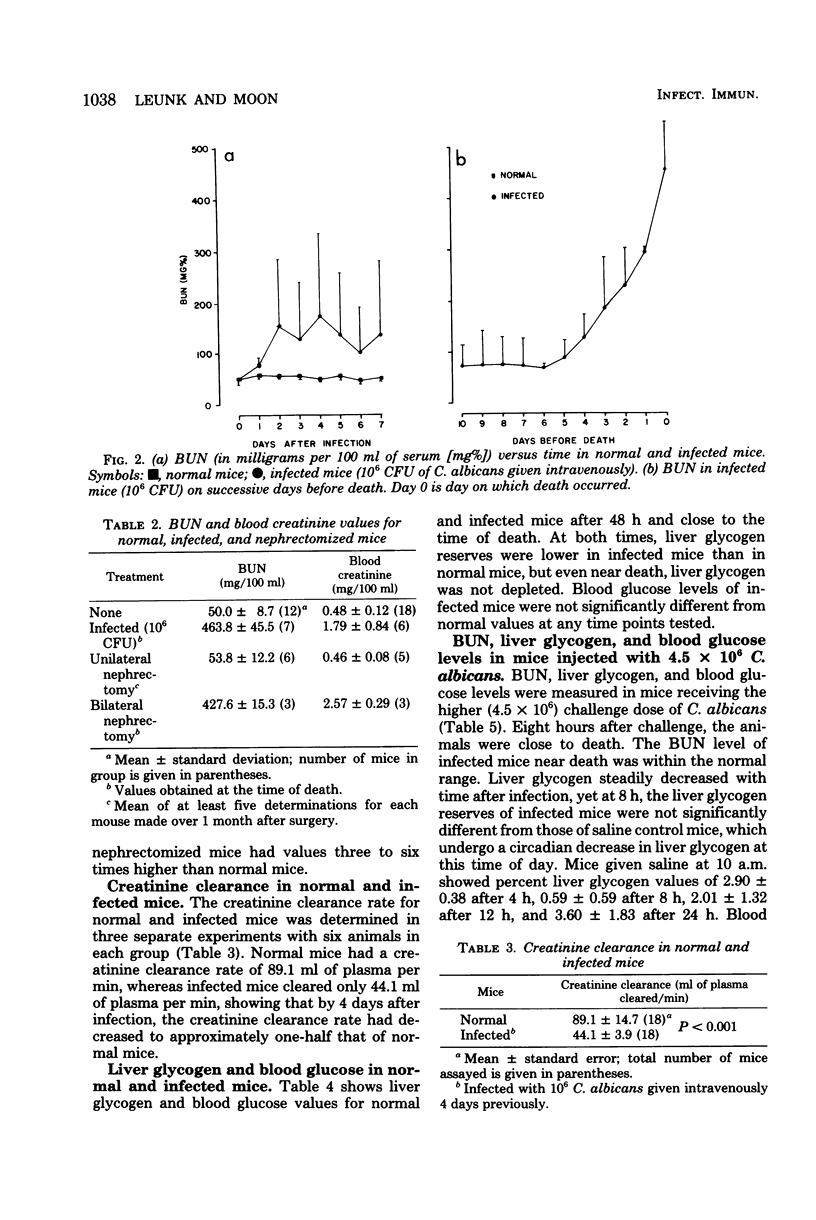
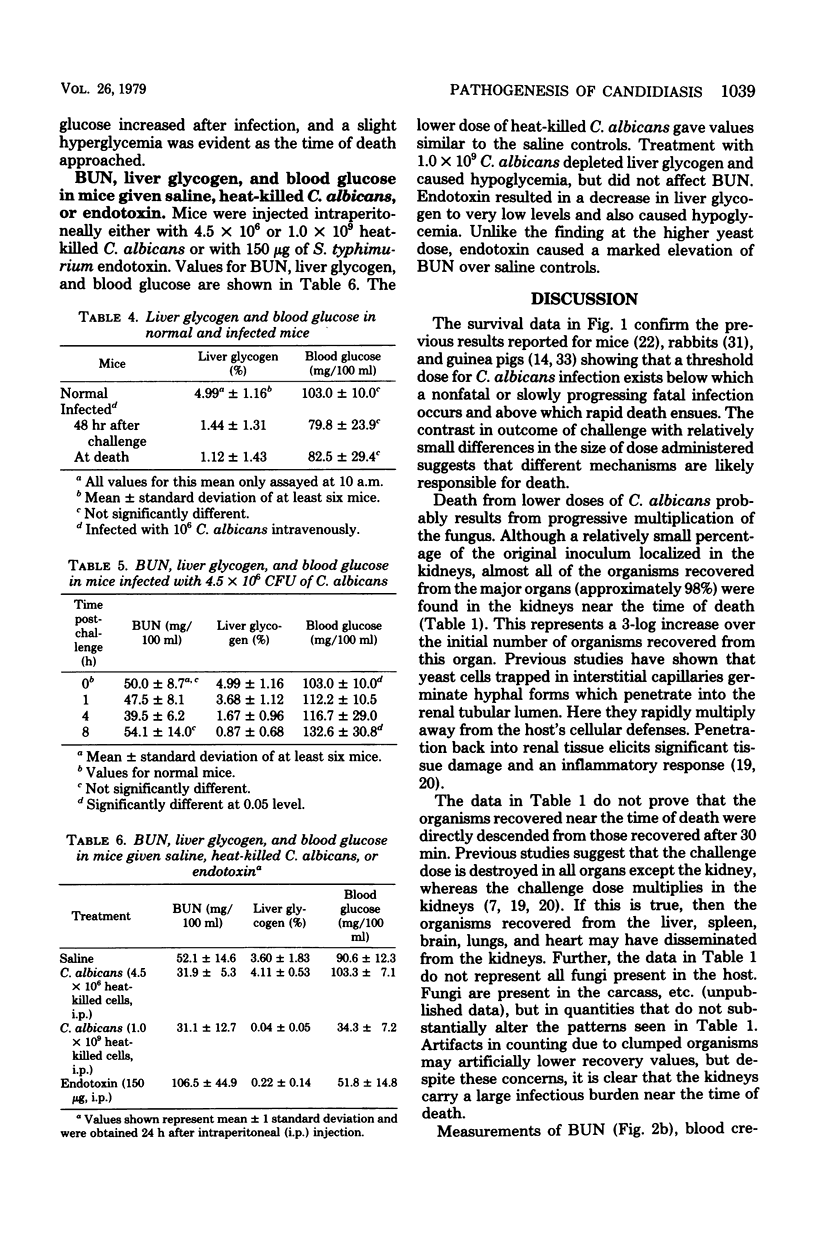
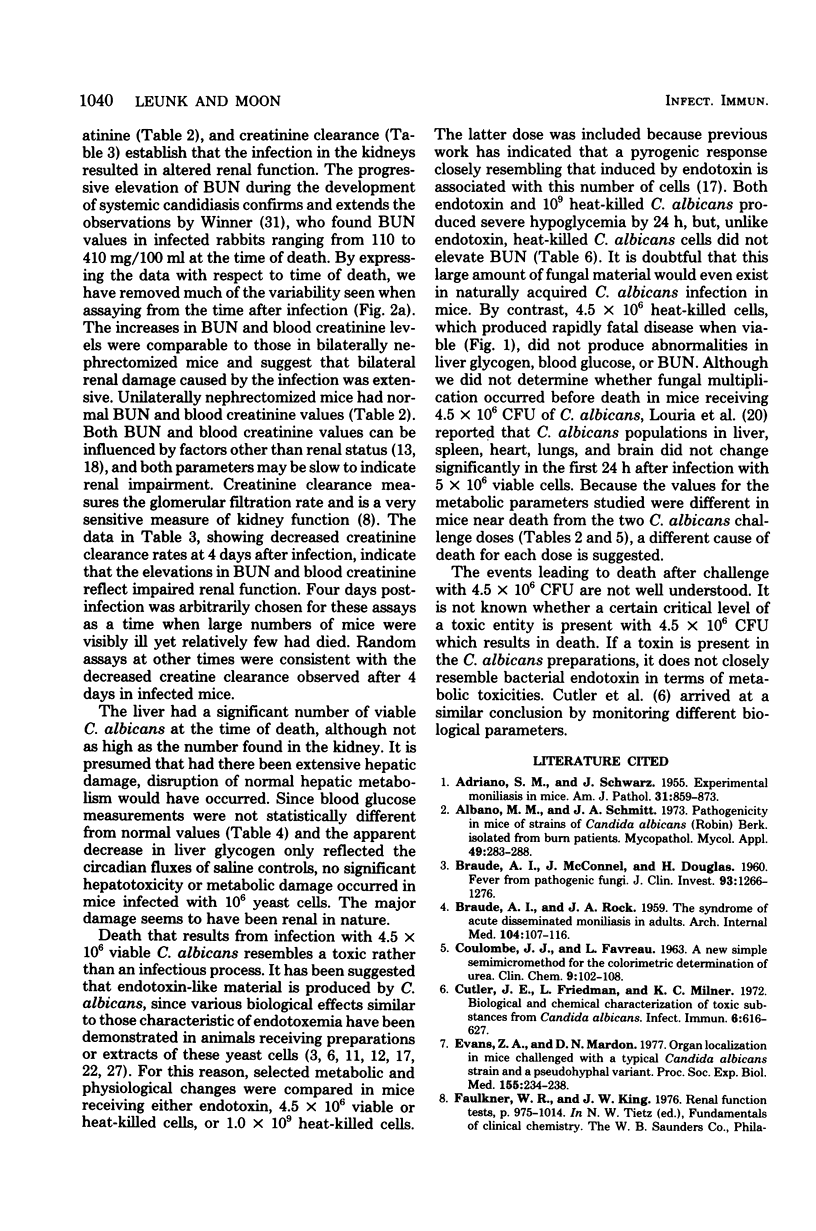

Selected References
These references are in PubMed. This may not be the complete list of references from this article.
- ADRIANO S. M., SCHWARZ J. Experimental moniliasis in mice. Am J Pathol. 1955 Sep-Oct;31(5):859–873. [PMC free article] [PubMed] [Google Scholar]
- Albano M. M., Schmitt J. A. Pathogenicity in mice of strains of Candida albicans (Robin) Berk. isolated from burn patients. Mycopathol Mycol Appl. 1973 Apr 30;49(4):283–288. doi: 10.1007/BF02050722. [DOI] [PubMed] [Google Scholar]
- BRAUDE A. I., McCONNELL J., DOUGLAS H. Fever from pathogenic fungi. J Clin Invest. 1960 Aug;39:1266–1276. doi: 10.1172/JCI104142. [DOI] [PMC free article] [PubMed] [Google Scholar]
- COULOMBE J. J., FAVREAU L. A new simple semimicro method for colorimetric determination of urea. Clin Chem. 1963 Feb;9:102–108. [PubMed] [Google Scholar]
- Cutler J. E., Friedman L., Milner K. C. Biological and chemical characterization of toxic substances from Candida albicans. Infect Immun. 1972 Oct;6(4):616–627. doi: 10.1128/iai.6.4.616-627.1972. [DOI] [PMC free article] [PubMed] [Google Scholar]
- Evans Z. A., Mardon D. N. Organ localization in mice challenged with a typical Candida albicans strain and a pseudohyphal variant. Proc Soc Exp Biol Med. 1977 Jun;155(2):234–238. doi: 10.3181/00379727-155-39780. [DOI] [PubMed] [Google Scholar]
- FUENTES C. A., SCHWARZ J., ABOULAFIA R. Some aspects of the pathogenicity of Candida albicans in laboratory animals. Mycopathol Mycol Appl. 1952 Jun 30;6(3):176–181. doi: 10.1007/BF02081434. [DOI] [PubMed] [Google Scholar]
- HASENCLEVER H. F., MITCHELL W. O. Production in mice of tolerance to the toxic manifestations of Candida albicans. J Bacteriol. 1962 Sep;84:402–409. doi: 10.1128/jb.84.3.402-409.1962. [DOI] [PMC free article] [PubMed] [Google Scholar]
- Hart P. D., Russell E., Jr, Remington J. S. The compromised host and infection. II. Deep fungal infection. J Infect Dis. 1969 Aug;120(2):169–191. doi: 10.1093/infdis/120.2.169. [DOI] [PubMed] [Google Scholar]
- Henrici A. T. Characteristics of Fungous Diseases. J Bacteriol. 1940 Feb;39(2):113–138. doi: 10.1128/jb.39.2.113-138.1940. [DOI] [PMC free article] [PubMed] [Google Scholar]
- Iwata K., Uchida K., Hamajima K., Kawamura A. Role of canditoxin in experimental Candida infection. Jpn J Med Sci Biol. 1974 Apr;27(2):130–133. [PubMed] [Google Scholar]
- KEMP A., VAN HEIJNINGEN A. J. M. K. A colorimetric micro-method for the determination of glycogen in tissues. Biochem J. 1954 Apr;56(4):646–648. doi: 10.1042/bj0560646. [DOI] [PMC free article] [PubMed] [Google Scholar]
- KOBAYASHI G. S., FRIEDMAN L. CHARACTERIZATION OF THE PYROGENICITY OF CANDIDA ALBICANS, SACCHAROMYCES CEREVISIAE, AND CRYPTOCOCCUS NEOFORMANS. J Bacteriol. 1964 Sep;88:660–666. doi: 10.1128/jb.88.3.660-666.1964. [DOI] [PMC free article] [PubMed] [Google Scholar]
- LOURIA D. B., FALLON N., BROWNE H. G. The influence of cortisone on experimental fungus infections in mice. J Clin Invest. 1960 Sep;39:1435–1449. doi: 10.1172/JCI104163. [DOI] [PMC free article] [PubMed] [Google Scholar]
- MOURAD S., FRIEDMAN L. Pathogenicity of Candida. J Bacteriol. 1961 Apr;81:550–556. doi: 10.1128/jb.81.4.550-556.1961. [DOI] [PMC free article] [PubMed] [Google Scholar]
- Myerowitz R. L., Pazin G. J., Allen C. M. Disseminated candidiasis. Changes in incidence, underlying diseases, and pathology. Am J Clin Pathol. 1977 Jul;68(1):29–38. doi: 10.1093/ajcp/68.1.29. [DOI] [PubMed] [Google Scholar]
- Oblack D., Schwarz J., Holder I. A. Biochemical examination of sera during systemic Candida infection in mice. Infect Immun. 1978 Mar;19(3):992–998. doi: 10.1128/iai.19.3.992-998.1978. [DOI] [PMC free article] [PubMed] [Google Scholar]
- Parker J. C., Jr, McCloskey J. J., Knauer K. A. Pathobiologic features of human candidiasis. A common deep mycosis of the brain, heart and kidney in the altered host. Am J Clin Pathol. 1976 Jun;65(6):991–1000. doi: 10.1093/ajcp/65.6.991. [DOI] [PubMed] [Google Scholar]
- Rogers T., Balish E. Experimental Candida albicans infection in conventional mice and germfree rats. Infect Immun. 1976 Jul;14(1):33–38. doi: 10.1128/iai.14.1.33-38.1976. [DOI] [PMC free article] [PubMed] [Google Scholar]
- SALVIN S. B. Endotoxin in pathogenic q fungi. J Immunol. 1952 Jul;69(1):89–99. [PubMed] [Google Scholar]
- WINNER H. I. An experimental approach to the study of infections by yeast-like organisms. Proc R Soc Med. 1958 Jul;51(7):496–499. [PMC free article] [PubMed] [Google Scholar]
- WINNER H. I. Experimental moniliasis in the guinea-pig. J Pathol Bacteriol. 1960 Apr;79:420–423. doi: 10.1002/path.1700790227. [DOI] [PubMed] [Google Scholar]
- WINNER H. I. Immunity in experimental moniliasis. J Pathol Bacteriol. 1956 Jan;71(1):234–237. doi: 10.1002/path.1700710132. [DOI] [PubMed] [Google Scholar]
- Winblad B. Experimental renal candidiasis in mice and guinea pigs. Acta Pathol Microbiol Scand A. 1975 Jul;83(4):406–414. doi: 10.1111/j.1699-0463.1975.tb01890.x. [DOI] [PubMed] [Google Scholar]
- YOUNG G. The process of invasion and the persistence of Candida albicans injected intraperitoneally into mice. J Infect Dis. 1958 Mar-Apr;102(2):114–120. doi: 10.1093/infdis/102.2.114. [DOI] [PubMed] [Google Scholar]


